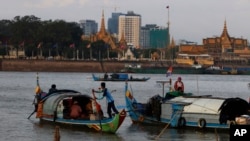The Mekong River Commission has expressed concerns over the “worrying” levels of the critical Mekong River and has asked China for more information about its hydropower dams.
The inter-government body released a statement on Friday and said water levels between Jinghong hydropower station in China’s Yunnan province and the Mekong Delta in Vietnam “have fallen to worrying levels.”
“Water levels have dropped considerably since the beginning of the year due to lower rainfall, flow changes upstream, hydropower operations in the Mekong tributaries, and outflow restrictions from the Jinghong dam,” read the statement.
“There have been sudden rises and falls in water levels immediately downstream of Jinghong and further down to Vientiane,” said Winai Wongpimool, director of the Mekong River Commission’s Technical Support Division in the same statement.
Wongpimool said China and lower Mekong countries needed to share more flow data and plans for water releases.
The Mekong River Commission and China’s Water Resource Ministry signed an agreement last December to share hydrological data twice a day from two stations on the upstream – the mainstream dam in Yunjinghong and another at Manan, both in Yunnan province.
In Cambodia, the MRC said water levels in Stung Treng and Kratie province fluctuated between -0.02 m and 0.05 m, but that the levels remained higher than the long-term average.
However, Mekong River levels at Kampong Cham, Neak Luong, and Bassac in Phnom Penh were declining since November and were lower than long-term averages.
Kol Vathana, deputy secretary-general of the Cambodian National Mekong Committee, said dam construction was one of the causes of low water levels in the Mekong because hydropower companies need to store water for producing electricity. He added that climate change, including drought, was also affecting water levels.
“I don’t support neither what China has done nor any research which is not based on facts,” he said. “There are other factors, not only damming of the river.”
Chan Youttha, a secretary of state at the Water Resources and Meteorology Ministry, said the Mekong water levels were “a bit lower” than the average, but did not want to comment further.
Brian Eyler, the Southeast Asia program director at the Stimson Center in Washington, D.C., said the organization’s Mekong Dam Monitor had similar findings and concerns as those raised by the MRC.
He said levels at Chiang Saen in Thailand and Vientiane, Laos, are much lower than they should be given the quantities of water present in the upper basin. He said promoting natural flows of the river would help bring back normalcy to water levels.
“The major reservoirs at Xiaowan and Nuozhadu are nearly full - collectively they hold about 40 billion cubic meters of water,” he said, referring to two hydropower dams in China’s Yunnan province.
“Those reservoirs will likely begin to release water soon and those releases will eventually show up downstream as part of their normal dry season operations patterns.”
Chab Sophat, 31, a fisherman in Stung Treng province’s Siembok district, has seen the water level change from year to year and estimated it was currently around two meters lower than previous years where he lived and fished.
“Because the water level has changed there are fewer fish. Some days, I can’t even catch one kilogram,” he said.








